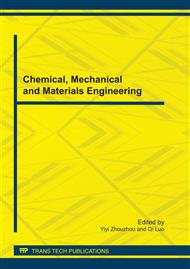p.270
p.276
p.282
p.288
p.293
p.298
p.304
p.309
p.318
The Influence of Gear Parameters on Oil Film Thickness of Tooth Surface
Abstract:
Applying elastic-hydrodynamic lubrication theory, oil film thickness of tooth surface was studies in accordance with the quasi-steady state. This paper focused on the influence of gear parameters such as gear ratio, module and center distance on the thickness of oil film of tooth flank. The results show, as speed ratio increases, oil film thickness increases significantly. When the number of teeth is fixed, oil film thickness increases significantly with the increase of module. When center distance is fixed, oil film thickness declines greatly with the increase of module in both into meshing and out of meshing points. Therefore when center distance is fixed, less module and more teeth are selected,on the condition that gear intensity is met. By results analyzing, the minimal oil film thickness may occur in the single tooth meshing area and into meshing or out of meshing points.
Info:
Periodical:
Pages:
293-297
Citation:
Online since:
July 2011
Authors:
Keywords:
Price:
Сopyright:
© 2011 Trans Tech Publications Ltd. All Rights Reserved
Share:
Citation:


